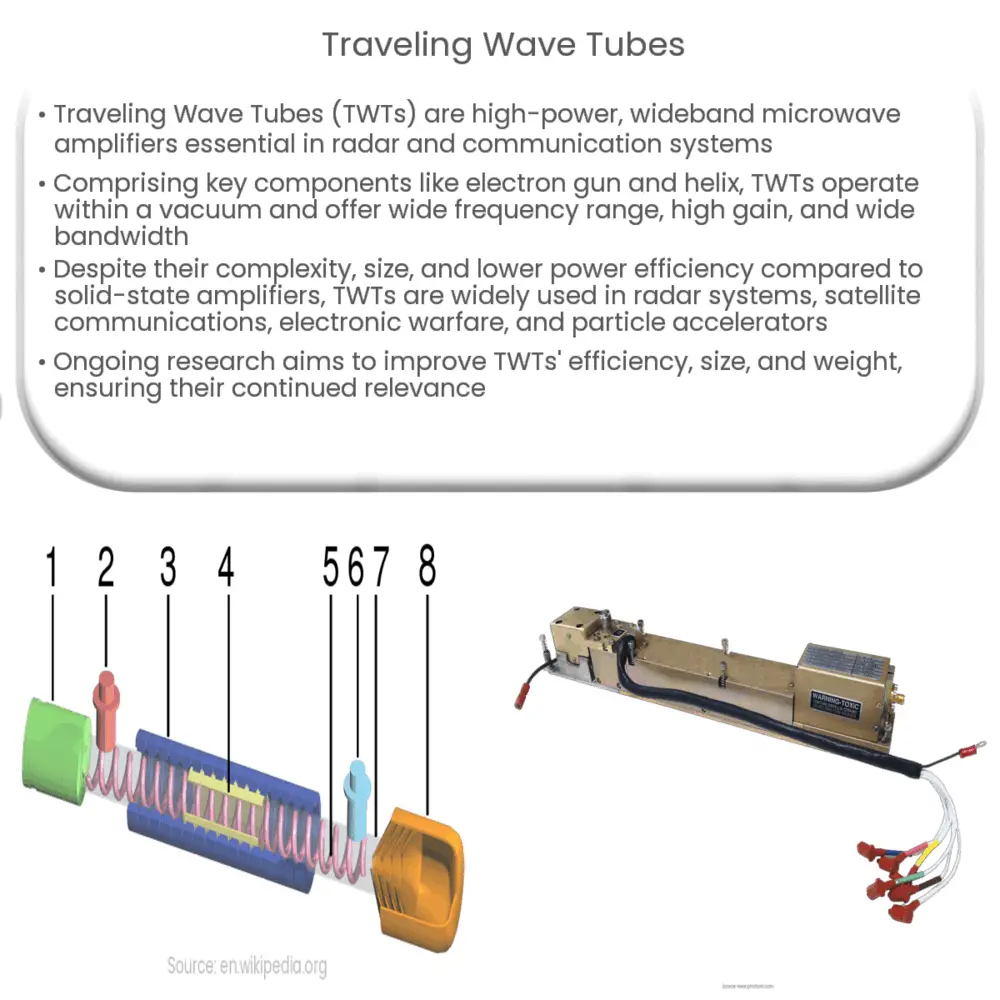Traveling Wave Tubes are vacuum-based devices that amplify microwave signals with high gain and wide bandwidth, used in radar, communication, and satellites.

Traveling Wave Tubes: A Comprehensive Introduction
What are Traveling Wave Tubes?
Traveling Wave Tubes (TWTs) are specialized vacuum tubes that are commonly used as high-power, wideband, and linear amplifiers for microwave frequency signals. Invented by Rudolf Kompfner in 1943, TWTs have since become an essential component in radar, communication systems, and satellite technology, enabling the transmission of signals over long distances with minimal loss and distortion.
How do Traveling Wave Tubes work?
At the core of a TWT is a helix, a coiled wire that acts as a slow-wave structure. The helix is housed in an electron beam-controlling cylindrical tube, which is encased within a vacuum. The electron beam is generated by an electron gun, and its velocity is controlled by an external magnetic field.
When a microwave signal enters the TWT, it travels along the helix, interacting with the electron beam. The electrons, which move at a similar velocity to the microwave signal, transfer energy to the signal, amplifying it. As the microwave signal continues to travel along the helix, it accumulates energy, resulting in significant amplification by the time it exits the TWT.
Key Components of a Traveling Wave Tube
- Electron Gun: Generates the electron beam that interacts with the microwave signal to amplify it.
- Helix: A slow-wave structure that enables the interaction between the microwave signal and the electron beam. The helix is critical to the performance of a TWT, as it determines the frequency range and gain of the device.
- Collector: Captures the spent electron beam after it has transferred its energy to the microwave signal. The collector converts the remaining kinetic energy of the electrons into heat, which is then dissipated by a cooling system.
- Magnetic Field: An external magnetic field is used to control the velocity and trajectory of the electron beam, ensuring that it remains focused and properly aligned with the helix.
- Vacuum Tube: The TWT operates within a vacuum to minimize energy loss due to interactions with air molecules and to prevent the formation of plasma, which could damage the device.
Advantages of Traveling Wave Tubes
Traveling Wave Tubes offer several advantages over other microwave amplification technologies, such as solid-state amplifiers and klystrons. Some of the key benefits include:
- Wide Frequency Range: TWTs can operate over a broad range of frequencies, typically from 0.3 GHz to 50 GHz or higher. This makes them suitable for a wide variety of applications, from radar systems to satellite communications.
- High Gain: TWTs can achieve high gain, often in the range of 40 to 60 dB or more, enabling the amplification of weak signals for transmission over long distances.
- Wide Bandwidth: The bandwidth of a TWT can be several gigahertz, allowing for the simultaneous amplification of multiple signals or channels.
Disadvantages of Traveling Wave Tubes
Despite their numerous advantages, TWTs also have some drawbacks that must be considered when selecting an appropriate microwave amplifier for a specific application. These include:
- Complexity and Cost: TWTs are complex devices with many components, making them more expensive to manufacture and maintain compared to some solid-state amplifiers.
- Size and Weight: The vacuum tube and cooling systems required for TWTs can result in larger and heavier devices, which may not be suitable for all applications, especially in space-constrained environments.
- Lower Efficiency: TWTs tend to have lower power efficiency compared to solid-state amplifiers, which can lead to higher power consumption and increased cooling requirements.
Applications of Traveling Wave Tubes
Traveling Wave Tubes have been widely adopted in various industries and applications due to their unique capabilities. Some of the most common uses for TWTs include:
- Radar Systems: TWTs are used in radar systems for both military and civilian purposes, providing high-power amplification for signals used in air traffic control, weather forecasting, and defense applications.
- Communications: TWTs play a crucial role in satellite communications, enabling the transmission of signals over long distances with minimal loss and distortion. They are also used in terrestrial microwave communication links and undersea cable systems.
- Electronic Warfare: TWTs are employed in electronic warfare systems, such as electronic countermeasures (ECM) and electronic support measures (ESM), to amplify signals for jamming or intercepting enemy communications and radar signals.
- Particle Accelerators: TWTs are utilized in some particle accelerator facilities to provide high-power microwave signals required for accelerating charged particles to high velocities.
Future of Traveling Wave Tubes
Despite the ongoing development and adoption of solid-state amplifiers, TWTs continue to be relevant in many applications due to their unique capabilities. Research efforts are being directed towards improving the efficiency, size, and weight of TWTs to enhance their competitiveness with solid-state technologies.
One promising area of research involves the development of new materials and manufacturing techniques for TWT components, such as advanced helix structures and electron guns. These innovations could result in significant performance improvements, making TWTs even more attractive for a wide range of applications.
Conclusion
Traveling Wave Tubes remain an essential technology for amplifying microwave signals in a variety of industries and applications, from radar systems to satellite communications. Their wide frequency range, high gain, and wide bandwidth make them indispensable for many critical systems. Although solid-state amplifiers have gained traction in recent years, ongoing research and development in TWT technology ensure that they will continue to play a vital role in the future of microwave signal amplification.

